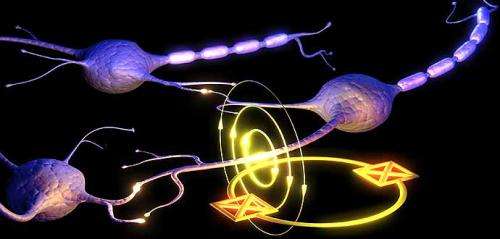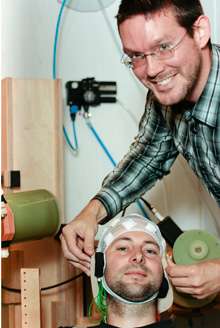Advanced brain investigations can become better and cheaper

(Medical Xpress)—An important method for brain research and diagnosis is magnetoencephalography (MEG). But the MEG systems are so expensive that not all EU countries have one today. A group of Swedish researchers are now showing that MEG can be performed with technology that is significantly cheaper than that which is used today – technology that can furthermore provide new knowledge about the brain.
MEG is used today as a diagnostic system in many highly-specialized hospitals. Applications include pre-operative planning for brain surgery and diagnosis of epilepsy and dementia. A single MEG system costs roughly 3M€ to buy and 200k€ in annual running costs. Because of the high price tag, there is currently not a single MEG system in many countries with high-tech medical care, including Sweden.
A group of researchers at Chalmers University of Technology and the University of Gothenburg are now working on technology that can make MEG far more accessible. The vision is an MEG system that is simple and cheap enough to be available at every hospital, while furthermore providing totally new possibilities for fundamental investigations in brain research.
At the heart of the system is a new class of sensors that, unlike today's MEG sensors, don't require cooling to -269 Celsius. Instead, these work at -196 Celsius. This capability provides many advantages:
"One of them is the reduction of insulation between the sensors and the subject's head," says Dag Winkler, professor of physics at Chalmers. "The sensors can therefore get much closer to the brain so that one can take a more high-resolution picture of brain activity."

With today's technology, you can record activity from a patch of the brain that is roughly the size of a 1€ coin. With "Focal MEG" – MEG with liquid-nitrogen cooled sensors – the precision can be improved such that you're recording from a patch of the brain that is a fraction of that size.
One example of what that can lead to is diagnosis of autism in children at a younger age – something that would be very meaningful considering how critical it is for these children to get the right help as early as possible.
"Another important advantage with Focal MEG is that the coolant the hardware requires is just liquid nitrogen", Dag Winkler adds. "Today's MEG requires liquid helium, which is extremely expensive. Furthermore, one can build the hardware with far more flexibility and less complication when using nitrogen instead of helium."
The Gothenburg researchers have shown that Focal MEG works for advanced brain investigations. Using two sensors they developed, they have successfully recorded spontaneous brain activity –something that had never been done before with liquid-nitrogen cooled sensors. The ability to record spontaneous brain activity (as opposed to averaged activity from repetitive stimulation) is a solid indication that they can record more complicated brain activity.
"The prevailing assumption among MEG researchers has been that MEG with liquid-nitrogen cooled sensors isn't feasible," says Justin Schneiderman, assistant professor in biomedical engineering at the University of Gothenburg and MedTech West. "But now we've begun to expose holes in that assumption by demonstrating good sensitivity to two well-known brain waves from well-understood parts of the brain."
The researchers have furthermore made an unexpected finding. They have recorded an uncharacteristically strong brain wave – the so-called theta rhythm – from the back of the brain. Today's methods tend to find theta waves only in other parts of the brain.
"This is quite exciting," says Mikael Elam, professor in clinical neurophysiology at the University of Gothenburg. "It may be an as-yet undetected type of brain signal that can only be found when one measures as close to the head as we do."
More information: apl.aip.org/resource/1/applab/v100/i13/p132601_s1
















